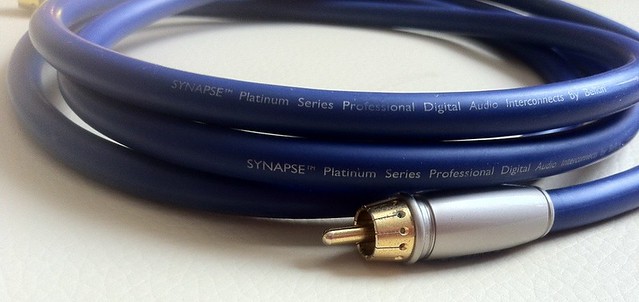This is a sort of “legendary” coaxial cable, since, when in production, it used to cost about 7$, and then it got to a “cult status” thanks to Romy The Cat (owner of GoodSoundClub website), and, subsequently, thanks to several Museatex dac owners.
The Synapse Platinum is made of stranded wire and measures around 73 ohms, which is already pretty close to the 75 ohm specification (several coaxial cables are far from that); it’s generally more straightforward to make coax cables that measure better, due to solid core design (like Acustic Revive).

I have used Belkin Synapse cables with multiple DAC’s: a Museatex Bitstream upgraded in 2010, Assemblage DAC 3.0, Yulong DAH-1, and, as of late, Museatex Idat-44 Mobile.
Some people describe the Belkin as capable of filtering the unwanted upstream jitter, as if not adding nor removing anything, but I think it does have its own signature.
When using it with the Bitstream and Assemblage, comparing it against two different Moray James revisions, I got consistent results: the Belkin Synapse offered great sense of bass texture and depth. The mids were less believable than the Moray, sounding more diffuse… “relaxed”, as many said, but less alive. Treble was a bit less smooth than earlier Moray James. Soundstage of the Belkin Synapse was the most open and biggest, against which the Morays couldn’t compete.
By comparison, the Moray James had a more saturated and present tonality, midrange-driven.
Back then, I ended up preferring the Moray James when using the Bitstream and the Assemblage: the Moray cables could give their own touch of saturated coloration, to the painture, making it very lifelike.
During that same period, I used to have two Belkin Synapse cables, and I decided to test them as analogue cables, for fun, with the following results: every characteristic I could hear when using the Belkin Synapse as digital cable, was exaggearted: using the Belkin cables as analogue cables, made the sound very bassy, where the bass was “dusty”, muffled, extremely deep and powerful. The midrange was too distant, and treble a bit cold. Definitely a no go as analogue cables, but very useful as digital.
Lately, I have repurchased a Belkin Synapse digital cable to use with the Idat-44m. In this case, the sonic effect has been hugely positive. The Idat-44m is very midrangey, powerful and cohesive, albeit it used to miss the sense of wholeness that only my older upgraded Museatex Bitstream DAC used to have.
Compared to all my other DAC’s, the Idat-44m sounds “matte”, while the others have, more or less, a layer of “digital” gloss.
The addition of the Belkin Synapse in my Idat-44m system, makes the bass decay longer, more powerful, but still very believable and never out of place. The soundstage gains “pavement” thanks to such bass behaviour, and a bigger sense of scale; the whole sound is saturated and much bigger, adding up to the more polite signature that was resulting from the Idat44m chained with the Audiophilleo for example, and making for the most analogue sounding digital source I have been hearing for years.
I have been trying the cable at a friends’ place with his speaker system: Audiomeca Mephisto cd player, AudioNote 2.0 DAC, Opera Consonance Cyber 222 Mk2 preamp, Korsun V6i and BW CM9. We tried two coaxial cables he had (Synergistic Research Corridor Reference, and a custom DIY one) along with the Belkin. We agreed that the Belkin was the best based on a few parameters: much better sense of three-dimensionality and sound depth, more precise, vivid treble without any bad peaks, and clearer bass separation across the space depth. As a downside, a bit of added syrupiness at the upper bass-lower midrange junction. Beyond its technical qualities, the more powerful bass could give the right sense of drama to certain tracks, like “Sneen Daler Stille” by Nina Pedersen. The Synergistic Research cable, by contrast, was the too polite and was definitely taking away from the spirit of the track.


